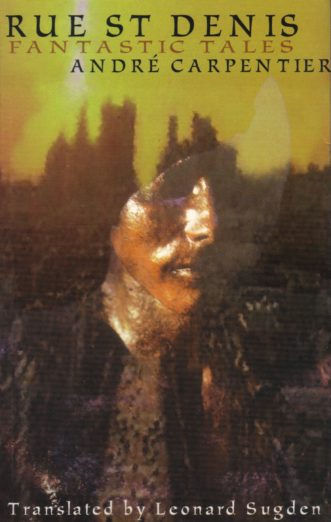 By ANDRE CARPENTIER (Ekstasis Editions; 1978/2001)
By ANDRE CARPENTIER (Ekstasis Editions; 1978/2001)
Quebec literature is all-but nonexistent to English speaking readers, and that’s particularly true of the horror/thriller variety. Quebec-based genre specialists like Patrick Senecal and Michael Tremblay are little known (if at all) in English translation, and that’s also true of Andre Carpentier, Quebec’s “master raconteur.”
RUE ST. DENIS is one of the small handful of Carpentier books available in English (courtesy of translator Leonard Sugden). Having initially appeared in French back in 1978, it was the first of Carpentier’s many short story collections.
The book consists of nine psychologically based supernatural tales situated around the Montreal street Rue St. Denis. All the stories are strong, although I’m not exactly jumping-up-and-down enthusiastic over any of them.
Carpentier’s narratives are close to those of the late Robert Aickman, with impeccably sketched characters caught up in increasingly skewed supernatural shenanigans that would seem to spring directly from the protagonists’ own unquiet psyches. The more wise-assed among you might term this collection “Aickman Lite,” but in fact Andre Carpentier’s true strengths are the supple clarity of his prose and his unerring grasp of unquiet psychology.
It’s those virtues that characterize the premiere story “Perrine Blanc’s Seven Dreams and Reality,” which isn’t especially original or unpredictable, but is compelling in its characterization of a disturbed woman moved to take part in a dangerous dream therapy. Strong characterizations also enhance “Magus Pichu Master of Magic,” about brothers who attempt to use magic to enact a vicious revenge, and “The Heaven-Sent World Map,” concerning a spectral map of the world with horrific properties.
A haunted house of sorts figures in “Bi’s Bell,” wherein the title character meets his doom because he “refused to give up a part of himself for a certain shred of hope…” Of a similar hue is “Madame Corriveau’s Chest,” about a man, a woman and a fateful antique chest, and “Victorine’s Flower Shop,” about witchcraft and mob violence.
The final story “The Between-Time Bookshop” ventures into science fiction territory in its account of a young man’s ominous encounter with a century-old bookshop. Again, the narrative is somewhat predictable, but the prose and characterizations are stellar, making it a good representation of the RUE ST. DENIS’ overall strengths.
